Learn about the Great Sphinx of Giza, and different changes the Sphinx endured through time.

Karnak. (Dromos) Alley with ram-headed sphinxes / 1st Dynasty
A sphinx was originally meant to be a personification of the king.
The human head, wearing pharaonic regalia, was fused with the body of a lion, thus sharing the qualities the powerful animal possessed. Namely its power, the swiftness of its attack, and its majestic authority.
By these very virtues, it was also considered a symbol of protection. Unsurprisingly, statues of sphinxes coutd be found along the dromos, protectors of the path taken by the gods to reach the temples.
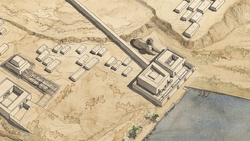
Pyramids of Gizeh - Sphinx / 1997 / Jean-Claude Golvin
Over the centuries, enthusiasts and historians alike have wondered... Who built the Sphinx? For what purpose? And who does it represent?
These questions remain unanswered. Several theories do exist however, some more credible than others.
One theory supposes that Djedefre chose to pay homage to his father, Khufu, by building the Great Sphinx of Giza.
The stone temple on the eastern face of the Sphinx would have been added later on by his brother and successor, Khafre, in order to strengthen the divine worship of their father. It would be the first Egyptian temple oriented with the sun.

Royal Head (Didoufri), (also known as Djedefre) / 4th Dynasty
Another theory suggests that the Sphinx was built by Khafre, and was meant to represent him.
The arguments to support this hypothesis are based on the fact that the limestone beds used for the main work of the temple of the Sphinx are geographically and architecturally similar to the Valley Temple of Khafre.
Some believe that Khufu himself built the Sphinx, which was later finished under his successors, Djedefre and Khafre.
These arguments are based on the stylistics of the engraving, the typology of the nemes, and the absence of a beard at the time of construction.
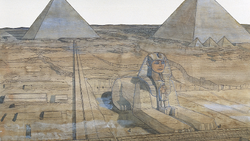
Temple Sphinx / 1997 / Jean-Claude Golvin
While ancient Egypt, as a whole, leaves a rather monochrome vision of its monuments and statuary, it is vital to understand that in ancient times, absolutely everything was painted.
The sun eating away at the pigments of the colors, the sand, the climate and the implacable impact of time unfortunately destroyed the glorious colors of the Sphinx of Giza.
Documents from an Arab Egyptologist of the 12th century Abd al-Latif al-Baghdadi, indicate that traces of red were still visible in his time.
Today, however, the only color that remains are traces of red close to the ears of the Sphinx, as well as hints of blue and yellow on the nemes, traditional colors for that type of headdress.
The pigments for the color red was manmade, obtained by mixing different products such as clay, quartz sand and very finely crushed hematite.
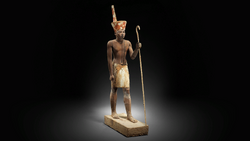
Guardian Figure (wearing the red crown of Lower Egypt) / circa 1919-1885 BCE
(Behind the Scenes)
Red had a strong symbolism in ancient Egypt. It was both the color of life and the color of death. It could represent the sands of the desert, or the brilliance of the sun. Red was also associated with the god Seth, vengeful and destructive.
The Egyptian word for red, dSr, is also the word which was used to signify the desert, or the royal crown of Lower Egypt.
In art, red was also the color used to paint the bodies of men, while the yellow was used for women.
It is possible that there were also color restoration efforts during the Saite Period about 600 years before Cleopatra's rule, as indicated by notes on the Inventory Stele, discovered in 1858 by Auguste Mariette.
Itis because of this that the Team made the decision to display it with its full range of colors, even though the Sphinx's colors would have likely faded by Cleopatra's time.
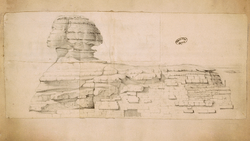
Side view of the Sphinx of Gizeh, Auguste Mariette papers / 1853
Dating from the 4th dynasty, approximately 2600-2500 BCE, the Great Sphinx of Giza is the oldest and largest sphinx that we know of.
Carved from a natural limestone outcrop, the Sphinx measures 19.8 meters in height, 73.2 meters in length and 14 meters in width.
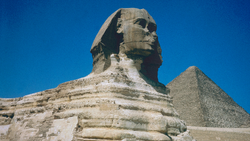
Sphinx of Khafre, with the pyramid of Cheops on the horizon / circa 1919-1885 BCE
(Behind the Scenes)
In order to bring polish to the imposing monument, several blocks of limestone were added after the initial construction phase. Since then, there have been numerous attempts at preservation.
The polish present in the game integrates some aspects of modern restoration attempts. The team made this choice to present a more iconic version of the Sphinx of Giza to the player.
Today the Sphinx is called The Terrifying One. This appellation is translated from its Arabic name, Abu'l Hôl, which in turn was derived from Balhouba, in Coptic}.
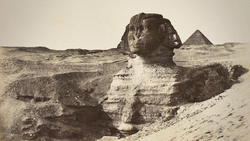
Gizeh: Sphinx / 19th Century
The Sphinx as a whole was carved in situ, from a natural stone promontory.
Its head was built in a limestone peak of the Mokattam plate, and the body was sculpted in the underlying rock layer where it is located.
The degradation of the Sphinx is due in particular to wind erosion and the different quality of limestone used in its construction. The level of sodium contained in the groundwater which abuts the stone is also a contributing factor.

Gizeh. Sphinx & Great Pyramid of Cheops / 1909
The natural bedrock is seen through the oblique natural strata of the Sphinx's body that are similar to the surrounding limestone.
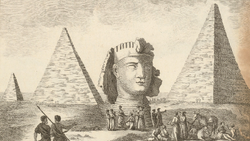
"L'encyclopedie", Diderot & d'Alembert, tome 12 / 1762
Since Antiquity people have always believed there was a hidden tomb deep within the Sphinx.
It is thought that attempts to plunder the Sphinx began as far back as the First Intermediate Period.
Since then, numerous attempts to pierce the Sphinx's secrets have been carried out, leaving indelible scars upon the monument.
(Behind the Scenes)
Twelve meters long and cut during pharaonic times, another entrance in the back of the Sphinx aroused curiosity. Although Thutmose IV attempted to seal it off, it was possibly reopened by treasure hunters. It was rediscovered by Howard Vyse, and mapped more recently by Mark Lehner.
This entrance at the back of the Sphinx leads to different cavities of a few meters each, in directions going inside the statue's body and under the surface. The team has used this opportunity to extrapolate a little more.
While there have been no major discoveries pertaining to the Sphinx of Giza in recent years, theories and hypotheses continue to emerge.
Without validation provided by archeological sources, however, they remain unsubstantiated.
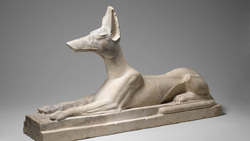
Recumbent Anubis / circa 664-30 BCE
The first of the main theories as to the Sphinx of Giza's meaning posits that the sphinx was originally a massive representation of the god Anubis. lts principal arguments are that that the head of the sphinx is disproportionate compared to the size of its body.
The second theory believes that the representation of two sphinxes on the stela of Thumosis IV would indicate that another stone sphinx had existed on the site itself, possibly even in paired symmetry on the other side of the Nile.
However, neither of these theories can be verified in any way.
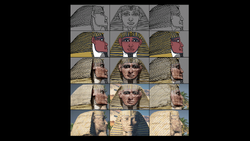
Montage of different versions of the sphinx during the development of the game / 2016 / Ubisoft
(Behind the Scenes)
Several scientific projects using new technologies have been put in place in the past decades.
The most important was led by Mark Lehner and his team, who specialize in the study and survey of the Giza plateau, including the Sphinx site. The mapping made it possible to see the materials used to construct the Sphinx, analyze the different layers of erosion, and figure out the most fragile areas to protect.
After a few attempts at giving the Sphinx artistic proportions, the team instead decided to use photogrammetry mapping to faithfulty reproduce the proportions of the Sphinx.
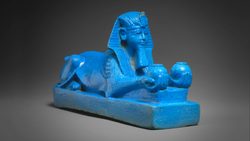
Sphinx of Amenhotep III, possibly from a Model of a Temple / circa 1390-1352 BCE
What the Sphinx of Giza represented during its construction, and how the sphinx was perceived by the Egyptians of the New Kingdom are two very different matters.
Originally a representation of the king imbued with the power of the lion, the sphinx was eventually viewed as a direct representation of the most divine.
It is theorized that kings of the New Kingdom believed that the Sphinx of Giza was the one who recognized and legitimized the ruler of Egypt.
Thus, despite the fact the Sphinx of Giza was partially buried under the sand during his reign, Amenhotep II knew that the monument was of great importance.
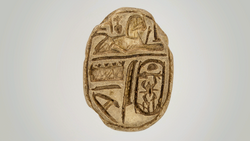
Scarab Inscribed with the Throne Name of Amenhotep II (featuring a shpinx) / circa 1427-1401 BCE
Amenhotep II built a second temple dedicated for the Sphinx-as-Horemakhet, to pay homage to Khufu and Khafre, his predecessors.
It became a common habit for this dynasty to spend time with their royal courts at the Sphinx. Its sanctuary became known as Setepet; The Chosen.
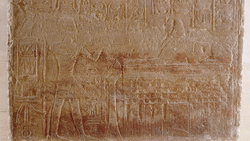
Ramses II, making an offering of incense and water to the Great Sphinx Harmakhis
Egyptologist Mark Lehner believed that Amenhotep Il built a statue of himself anchored between the paws of the Sphinx, likely to legitimize his reign, alongside a stela, found by Selim Hassan.
Many other pharaohs of this dynasty, such as Tutankhamun and Ramses II, also left marks of their passage in a similar fashion, sometimes even stripping the stones of nearby temples and pyramids to do so. Amenhotep II's son and successor, Thutmose IV, was a frequent offender.

Djizeh necropolis of Memphis - Sphinx & pyramids / 1851 - 1852
While sleeping between the Sphinx's paws, the future Thutmose IV saw in a dream the god Horemakhet proclaiming his coming accession on the throne of the Two Lands.
This was, of course, on the condition that he remove all of the sand covering the Sphinx, which stood guard as the personification of the god, and should thus never be engulfed by the sands of the desert.
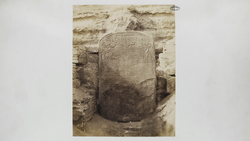
Pyramids of Gizeh (Works of Mr Mariette. Stela at the base of the Sphinx, excavated by Mr Mariette; Dec 1852, Egypt, Gizeh) / 1854
The 15-ton dream stela built by Thutmose IV to commemorate his dream was discovered by an Italian Egyptologist, Giovanni Battista Caviglia in 1818, when he undertook the task of freeing the Sphinx from the sand which had, yet again, covered it.
Caviglia was looking for an entrance into the structure of the Sphinx, but instead, he discovered an open-air chapel and stelas between the paws. Ashes from a ceremony were still present. Protected by sand, they quite possibly were from the last ceremonies in Roman times.
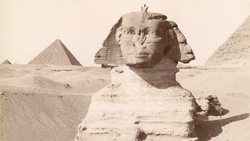
The Great Sphinx of Gizeh / 19th Century
That same year, Cavigilia discovered fragments of the Sphinx's beard that had probably been added during the New Kingdom.
If many of these pieces are held by museums in Cairo, a fragment is displayed at the British Museum, along with a piece of the uraeus that was on the Sphinx's headdress.
It is believed this fragment of beard was possibly kept in place thanks to the statue of Amenhotep II, which was supposed to be located under the head of the Sphinx.
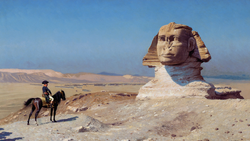
Bonaparte Before the Sphinx, by Jean-Leon Gerome; circa 1868
A popular cultural Legend purports that the nose of the Sphinx of Giza was lost during the time of Napoleon Bonaparte, to the cannon fire of French soldiers in training.
However, engravings from before the time of that campaign already depicted the Sphinx without a nose, indicating that it had been removed before the French campaign.
The most plausible hypothesis is based on the research of the German historian Ulrich Haarmann.
During the 1980s, Haarmann compiled medieval sources written by Arab authors. In doing so, he discovered that the sphinx was once perceived as a favorable omen, a deity supporting sediment-nurturing floods and crops.
Around 1378, a Sufi by the name of Mohammed Sa'im al-Dahr could not stand this vision of the monument and in an iconoclastic act, broke the nose of the Sphinx. According to the texts, he was then hanged and burned between the legs of the Sphinx for his crime.